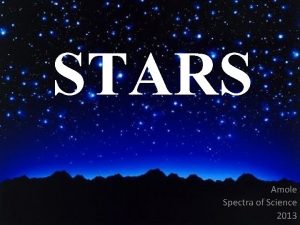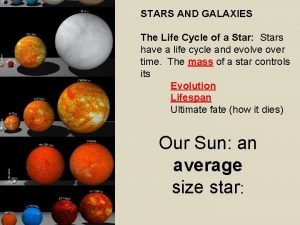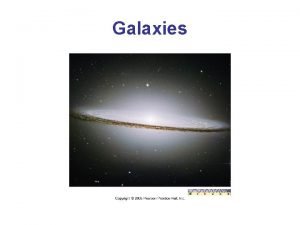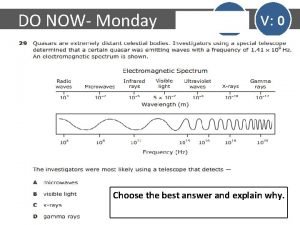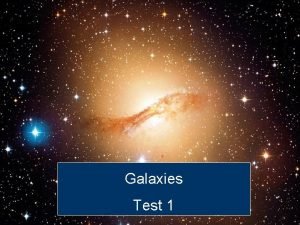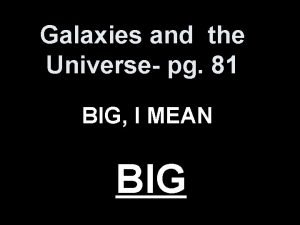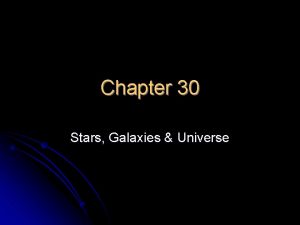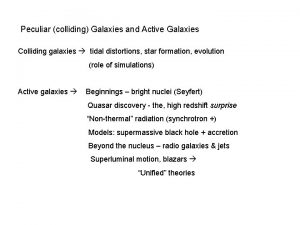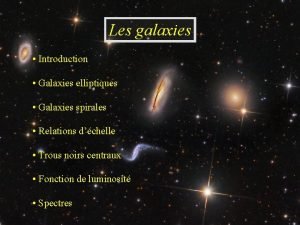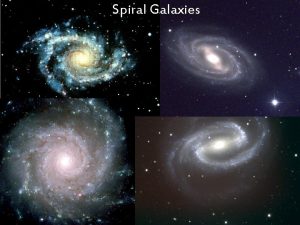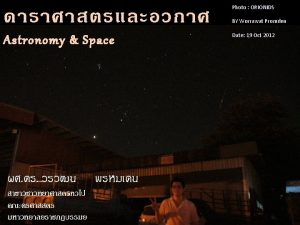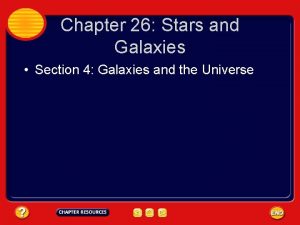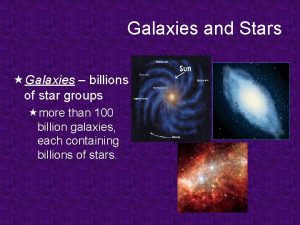Stars Galaxies and the Universe Course 3 3

















- Slides: 17

Stars, Galaxies, and the Universe- Course 3 3 -5 Lives of Stars

Nebula- A large cloud of gas And dust in space. Protostar – A contracting cloud of gas and dust with enough mass to form a star. White Dwarf – The blue-white hot cone of a star that is left behind after its outer layers have expanded and drifted out into space. Supernova – The brilliant explosion of a dying supergiant star. Vocabulary

Neutron Star – The small, dense remains of a high-mass star after a supernova explodes. Pulsar – A rapidly spinning neutron star that produces radio waves. Black Hole – An object whose gravity is so strong that nothing, not even light, can escape.

The Supernova of 1054 My Planet Diary pg. 116 In the summer of 1054, some Chinese astronomers noticed a “guest star” in the night sky. The star was so bright people could see it during the day! The star remained visible for almost two years. How did these ancient astronomers interpret it? Was it a sign that the emperor would be visited by an important guest? People from around the world recorded and interpreted the event differently. Almost 1, 000 years later, scientists realized the “guest star” was the explosion of a giant star 4, 000 light-years away. So powerful was the explosion that all life within about 50 light-years would have been wiped out. Now called Supernova 1054, its remains are known as the Crab Nebula. 1. Why was Supernova 1054 so notable? 2. How do you think ancient astronomers might have interpreted the event differently than astronomers today?

How Does a Star Form and What Determines Its Life Span? Stars do not last forever. Each star is born, goes through its life cycle, and eventually dies. A star is born when the contracting gas and dust from a nebula becomes so dense and hot that nuclear fusion starts. A nebula is a large cloud of gas and dust spread out in an immense volume. In the densest part of a nebula, gravity pulls gas and dust together. A protostar is a contracting cloud of gas and dust with enough mass to form a star; it’s like a “pre-star. ” Nuclear fusion begins in a protostar.

How Does a Star Form and What Determines Its Life Span? Pg. 117 How long a star lives depends on its mass. Small-mass stars use up their fuel more slowly than large-mass stars, so they have much longer lives. While small-mass stars may live for as long as 200 billion years, a large mass star may live only about ten million years. Life of a Star A star's lifetime depends on its mass. Explain- the yellow star has much less mass than the blue star and so will live longer. Explain why.

Assess Your Understanding pg. 118 1 a. Review- How does a star form from a nebula? _______________________________________________________ b. Summarize- What factor determines how long a star lives? _______________________________________________________ c. Predict- A star is twice as massive as the sun. How will its lifespan compare? ___________________________________________________ I get it! Now I now that stars are born when ______________________________________

What Happens To A Star When It Runs Out Of Fuel? Pg. 119 When a star begins to run out of fuel, its core shrinks and its outer portion expands. Depending on its mass, the star becomes either a red giant or a supergiant. After a star runs out of fuel, it becomes a white dwarf, a neutron star, or a black hole.

White Dwarfs pg. 119 Low-mass stars and medium mass stars like the sun take billions of years to use up their nuclear fuel. As they start to run out of fuel, their outer layers expand, and they become red giants. Eventually, the outer parts grow larger still and drift out into space, forming a glowing cloud of gas called a planetary nebula. The blue-white core of the star that is left behind cools and becomes a white dwarf. White dwarfs are about the size of Earth, but they have about as much mass as the sun. White dwarfs have no fuel, but they glow faintly from leftover energy. After billions of years, a white dwarf stops glowing. Then it is called a black dwarf.

Supernovas pg. 119 The life cycle of a high-mass star is quite different. These stars quickly evolve into brilliant supergiants. When a supergiant runs out of fuel, it can explode suddenly. Within hours, the star blazes millions of times brighter. The explosion is called a supernova. After a supernova, some of the material from the star expands into space. This material may become part of a nebula. This nebula can then contract to form a new, partly recycled star. Recall that nuclear fusion creates heavy elements. A supernova provides enough energy to create the heaviest elements. Astronomers think that the matter in the sun and the planets around it came from a gigantic supernova. If so, this means that the matter all around you was created in a star, and all matter on Earth is a form of stardust.

Figure 3: Supernova Remnant Cassiopeia A pg. 119 Cassiopeia A is the remnant of a once-massive star that died in a supernova explosion seen 325 years ago. Challenge- Explain the connection between your body and a supernova. _______________________ _______________________ ____________

Neutron Stars pg. 120 After a supergiant explodes, some of the material from the star is left behind. This material may form a neutron star. Neutron stars are the remains of high-mass stars. They are even smaller and denser than white dwarfs. A neutron star may contain as much as three times the mass of the sun but be only about 25 kilometers in diameter, the size of a city. In 1967, Jocelyn Bell, a British astronomy student working WITH Antony Hewish, detected an object in space that appeared to give off regular pulses of radio waves. Some astronomers thought the pulses might be signals from extraterrestrial civilization. At first, astronomers even named the source LGM, for the “Little Green Men” in early science-fiction stories. Soon, however, astronomers concluded that the source of the radio waves was really a rapidly spinning neutron star. Spinning neutron stars are called pulsars, which is short for pulsing radio sources. Some pulsars spin hundreds of times per second!

Black Holes pg. 121 The most massive stars- those that have more than 10 times the mass of the sun- may become the black holes when they die. A black hole is an object with gravity so strong that nothing, not even light, can escape. After a very massive star dies in a supernova explosion, more than five times the mass of the sun may be left. The gravity of this mass is so strong that the gas is pulled inward, pacing the gas into a smaller and smaller space. The star’s gas becomes squeezed so hard that it converts into a black hole. Its intense gravity will not allow even light to escape. No light, radio waves, or any other form of radiation can ever get out of a black hole, so it is not possible to detect directly. But astronomers can detect black holes indirectly. For example, gas near a black hole is pulled so strongly that it revolves faster and faster around the black hole. Friction heats the gas up. Astronomers can detect X-rays coming from the hot gas and infer that a black hole is present.

What Happens To A Star When It Runs Out Of Fuel? Pg. 119 As low-mass and medium-mass stars begin to run out of fuel, their outer layers expand they become red giants. Eventually, their outer layers drift off into space, forming a glowing cloud of gas called a planetary nebula. The blue-white core of the star that is left behind cools and becomes a white dwarf. White dwarfs have about the mass of the sun but are only the size of Earth. Fill in the missing stages on the diagram. Now think about where the sun fits on the diagram. On the lines describe what will happen to the sun when it runs out of fuel.

Apply it! pg. 120 An alien civilization is in orbit around a high-mass supergiant star. Should they stay or should they go elsewhere? Why?

What Happens To A Star When It Runs Out Of Fuel? Pg. 119 As high-mass stars begin to run out of fuel they become red supergiants. When a supergiant runs out of fuel, it can explode suddenly. The explosion, a supernova, blazes millions of times brighter. The remains of the high-mass star may form a neutron star. A neutron star may be only 25 kilometers in diameter yet contain as much as three times the mass of the sun. Rapidly spinning neutron stars are called pulsars, which give off regular pulses of radio waves. If the original star was extremely massive, what remains after a supernova may be a black hole. A black hole is an object with gravity so strong that nothing, not even light, can escape.

Assess Your Understanding pg. 121 2 a. Review- What determines if a star becomes a white dwarf, neutron star, or black hole? ________________________________________ b. Predict- Will the sun become a white dwarf, neutron star, or a black hole? Why? ____________________________________________ I get it! Now I know that after a star runs out of fuel, it becomes ___________________________________________________
 Chapter 30 galaxies and the universe
Chapter 30 galaxies and the universe Electromagnetic star
Electromagnetic star Star temperature chart
Star temperature chart The stars there are millions of stars in the sky
The stars there are millions of stars in the sky Spiral irregular and elliptical galaxies
Spiral irregular and elliptical galaxies Life cycle of galaxies
Life cycle of galaxies Facts about elliptical galaxies
Facts about elliptical galaxies E irregulars
E irregulars The pity relation for an adiabatic expansion is
The pity relation for an adiabatic expansion is Critical density
Critical density Types of galaxies
Types of galaxies Brainpop galaxies quiz answers
Brainpop galaxies quiz answers 4 types of galaxies
4 types of galaxies How are active galaxies classified?
How are active galaxies classified? Tipus de galaxies
Tipus de galaxies Properties of elliptical galaxies
Properties of elliptical galaxies Evolution of galaxies
Evolution of galaxies Universepg
Universepg


